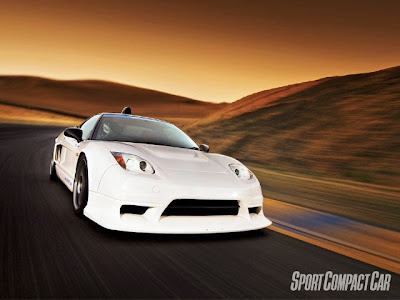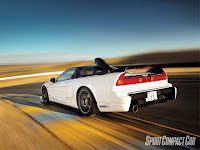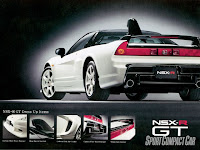
Honda NSX Type-R
The noise begins as a slight echo, cutting through the quiet silence of the still air. It soon crescendos into the distinctly hollow wail of an NSX exhaust note and Spoon Sports' white rocket suddenly appears over a nearby hill. The mid-engine Honda rides the curb, on the edge of adhesion, and devours the short straight ahead. By the time it's disappeared from view, the tingles have barely left my spine. I'm standing on the outside of Turn 2 at Infineon Raceway and in front of me is one of the greatest things that one could ever wish for - an empty racetrack.
As you may have noticed, this is no normal turbocharged NSX. For this test we've dispensed with the pedestrian and instead have lined up what can only be described as a Honda nerd's Internet bench racing fantasy. Yes, we've signed up the ultimate enigma, otherwise known as the Spoon Sports NSX Type-R GT.
To Honda fans, Spoon Sports needs no introduction. Founded more than 20 years ago by Tatsuru Ichishima, himself an amateur racer, Spoon is one of the most famous Honda tuning companies in existence. Spoon's distinctive yellow and blue paint scheme has appeared on numerous company racecars, campaigned in such events as the 25 Hours of Thunderhill and the Super Taikyu race series. Their philosophy has been built on optimization rather than re-invention, with a parts line-up that consists mostly of naturally aspirated engine assembly, exhausts, suspension kits, stronger drivetrain pieces, and cooling upgrades.
Spoon built its reputation and success through a history of race-derived parts that sought to improve upon, rather than completely replace, Honda's original engineering. For example, Spoon's infamous monoblock brake calipers are designed to function with stock brake rotors and engine balancing is more common than sleeving. Up until now, there wasn't a forced induction kit in sight and the Spoon catalog had a larger selection of mufflers and throttle bodies than high lift camshafts.
This NSX changes all that. From the outside this Honda appears to be an NSX Type-R GT, fit with a set of 17-inch Prodrive wheels. But it's not really that simple. The NSX Type-R GT is a mythical fable in the Honda world, modified beyond the standard 2nd-generation NSX Type-R with the use of carbon bumpers, larger side scoops, and that distinctive roof scoop. Five examples were built solely to homologate the car so that the Super GT (then JGTC) racecars could make use of the scoops and body dimensions. On the street legal GTs, the non-functional roof scoop terminates right onto the rear hatch glass.
The price of entry for a Type-R GT was nearly $500,000 when the car was announced. It's the rarest of all Hondas and some H-badge fans even cling to the belief that the five GTs were never built, with Honda having pulled an elaborate ruse on everyone the world over.
This Spoon NSX is, parts and build-wise, an NSX Type-R GT, but it isn't actually one of the original five. This Honda began life as a standard 2005 Honda NSX Type-R before it was disassembled by Spoon Sports. With years of partnerships and connections, Ichishima has built up a relationship with Honda of Japan that surpasses any dealings aftermarket tuners have with Honda here in the US. Through Honda of Japan, Spoon was able to source the OEM NSX Type-R GT parts necessary for a conversion, such as the bumpers and scoops.
But Spoon wasn't done there. This NSX was designed to be a complete Spoon-built car, not too unlike the wares available from Saleen or Ruf. Thus, a stiffer Spoon suspension was added along with more rigid Spoon monoblock front brake calipers. And you must have noticed by now that this NSX isn't wearing the distinctive yellow and blue Spoon colors that have become synonymous with their name. The reason is simple - only the racecars wear the yellow and blue paint. This NSX is even packing the original stereo system, which was a factory option on JDM Type-R models.
And because this is a true street car, it would need more power. The kind of big, honking, tire smoking power that blows the doors off anything else on the road. For that, Spoon would have to step into uncharted territory. A turbocharger kit was fabricated for the V6 engine using a single HKS 3037 turbo. With a tight engine bay making packaging difficult, the turbo is low mounted within the chassis, mere inches above the ground. The air-to-air intercooler is also low-mounted, with the compressor outlet nearly feeding directly into it. Scoops and ducting on the underside funnel air through the core and a custom Spoon oil pan and oil cooler kit help keep temps in check. Power output is now a claimed 420bhp, up from the factory rating of 280bhp. The turbocharger was chosen for response and low-end power, with boost coming on quickly and, unfortunately, tapering off as the RPMs reach redline.
We brought the Spoon NSX Type-R GT out to Infineon Raceway for our testing, which features elevation changes, blind crests, the quick downhill left Carousel turn, and the treacherous car-eating Turn 10. As well as this NSX drove, with empty pavement and curbing in front of us, we couldn't help but wish that we also had on hand Spoon's other NSX Type-R GT, the full race version. Prepared for the upcoming 55th Macau Grand Prix (which will have passed by the time you read this), the yellow and blue Spoon NSX Type-R GT racecar features an even stiffer suspension, stickier tires, and full safety prep.
Beyond its performance, perhaps one of the most interesting elements of this car is its availability. Spoon Sports will soon begin selling copies of this car to the general public, with early estimates for pricing hovering in the $135,000 range. An official announcement will be made at the 2009 Tokyo Auto Salon. We've received images from Spoon's Tokyo headquarters of readied GT bumpers and carbon-kevlar Recaro seats resting in storage after delivery from Honda. Spoon is even planning on providing this treatment to left-hand drive US-model NSXs, which should help owners step around tricky US importation laws governing ownership of Japanese-market vehicles.
The plan is for USDM NSXs to be shipped to Spoon, where the Acuras will then be completely disassembled, lightened, and modified with every single part out of the Honda catalog that makes a Type-R a Type-R, including the 3.2-liter V6 engine. Then the GT body cladding will go on, and the turbocharger kit will be bolted up. If you want your Spoon NSX Type-R GT to come with an automatic transmission, that can be arranged as well. It'll be turnkey and ready to go; one of the biggest wet dreams to emerge in recent years for Honda fans. Better start collecting those pennies now.
From The Driver's SeatThe dream of driving a car such as this is euphorically intoxicating. However, the prospect of actually doing it is decidedly sobering. In no uncertain terms, the NSX Type-R is the greatest production car that Honda ever produced. Add to that the mystique of this particular sample being loaded up with Spoon Sports, HKS, and Dome GT homologation components, and you have one very special automobile. Stuffing it in the fence would be bad.
Infineon Raceway is arguably the best road course on the West Coast. Mazda Raceway at Laguna Seca may have more prestige, and Willow Springs is faster, but the way the pavement is laid across Sonoma's rolling hills creates a complex rhythm that is unique to Infineon. The pleasure of negotiating the cresting corners is balanced by the terror of knowing that reinforced cement walls are waiting to devour wayward machinery and overconfident wheel-men. But that just makes sticking the perfect lap all the more rewarding.
Our original plan was to drive the car for a few sessions during one of Infineon's test days. Unfortunately, despite its heritage, the NSX was not allowed on the track with the other racecars since it didn't have a competition log book and safety equipment. However, the track officials were gracious enough to give us a few laps at the end of the day. The low sun was casting long shadows, ideal for photography but just one more element to encourage the butterflies in my stomach as I crawled into the cockpit.
The NSX-R has by far the most fitting interior of any car I've driven on a racetrack. It's hard to say if the thing is a racy luxury car or a luxurious racecar. The Kevlar seat is all business yet it's mounted to a power-sliding bracket. It took me a moment to figure out what all the switches did. My favorite directed the power antennae to only raise half way. Others operated the power windows, air conditioning, and what appeared to be an audio cassette player. With everyone waiting I couldn't stall any longer. I had to hit the most important switch of all, the ignition key.
As the Spoon Sports exhaust blurted out its cherry note I was greeted by a woman's voice. Admittedly my Japanese is poor but I'm pretty sure she was saying, "You are awesome. People envy you." Engineering Editor Chen later insisted that she was instructing me to fasten my seatbelt but he always was a bit of a player hater. With my belt secured I headed out on course to see what she could do.
First of all, the sounds that V6 made at 8000 RPM were incredible. Turbo cars normally can't sing like that. Accompanying were all the great whining, hissing, and choo-choo sounds from the turbo system itself. The power delivery was equally well orchestrated even if it wasn't as pronounced. Boost built up down low in the power-band then tapered off as the VTEC engine got into its natural realm. The feeling from the seat was that power was always there. However, as in any turbo car the throttle needed to be tipped a split second before you were going to get it.
Carving through the corners at around eight tenths was a piece of cake. The relatively small front tires ran out of grip before the rears. Keeping it on the track was just a simple matter of easing off the throttle when the steering wheel got light. It behaved exactly as you would want a six figure street car to behave. But if you asked for trouble she would give it to you. Dragging the brakes with my left foot while loading up the boost with my right would get it in and out of the hairpins a little quicker. However with both ends pushing against each other there was a lot of energy bound up. On one lap I pushed the limits in turn seven (the only corner with plenty of paved run-off room.) The car snapped into a smoky 360 before I could catch it. But again, I was asking for it.
The car's straight-line acceleration and braking abilities are clearly visible at the end of the telemetry graph. The car dumps 70 MPH in no time flat while approaching the final hairpin. Then it blasts from 37 to 104 MPH by the time it crosses start/finish, even with my cautious right-hand-drive shifting. My lap time of 1:57 flat was a little over three seconds slower than what I was able to do a few months earlier in the Spoon Sports RSX racecar. Although, I will admit to leaving a little more on the table with the NSX. The bottom line is that the Spoon Sports NSX-R GT is an impressive street car that can hold its own on the track. Wherever it is driven it will be awesome, and will be envied.
Engine
Engine Code: C32B
Type: 3179cc V6, aluminum block and heads, VTEC variable valve timing and lift, turbocharged and intercooled
Internal Modifications: Stock
External Modifications: HKS 3037 turbocharger, intercooler, exhaust manifolds, uppipe, and downpipe, Spoon Sports oil pan, exhaust,and high pressure radiator cap, custom oil cooler kit, air intake, and intercooler ducting
Engine Management Modifications: Bosch fuel pump, adjustable fuel pressure regulator
Drivetrain
Layout: Transverse mid-engine, rear-wheel drive
Drivetrain Modifications: Spoon Sports metal clutch and pressure plate
Suspension
Front: Spoon Sports coilovers
Rear: Spoon Sports coilovers
Brakes
Front: Spoon Sports monoblock brake calipers, slotted rotors, and stainless braided brake lines
Rear: Spoon Sports slotted rotors and stainless braided brake lines
External
Wheels: 17x7.5 (F), 17x8.5 (R), Prodrive PFF7
Tires: 215/40/17 (F), 255/40/17 (R), Bridgestone Potenza RE070
Body: NSX Type-R GT front bumper, rear bumper, side scoops, and roof scoop, custom front undertray
Interior: Recaro carbon kevlar bucket seats
The Nitpickers Guide To Building A NSX-R GT
The NSX-R GT was, in the end, just a dirty little trick that Honda used to pull a fast one on the GT Association, so that the real GT500 racecars could have larger dimensions to employ better aerodynamics. Aside from the pre-preg carbon fiber front and rear bumpers, side scoops, and drag inducing non-functional rear hatch scoop, the GT is no different from a standard 2002+ NSX-R.
So the first step to building your own Type-R GT is turning the base NSX into an NSX-R. But getting actual details and information on the already rare NSX-R isn't easy. Few in the US have ever seen one in person and most build their cars based off Internet myths and gossip. But, because the NSX-R and even the GT are so similar to the base NSX, making your own R or GT isn't impossible.
You'll first have to come to terms with the fact that there are certain things that can't be changed, like structural elements of the chassis. 1997 and up models have a strengthened and lightened chassis, which uses additional welding and different stamped gusseting as well as slightly different headlight bucket sheet metal to accommodate the later model NA2 bubble lights. NSX-Rs also get two aluminum chassis braces for the front subframe and frame rails.
In terms of weight reduction, there is absolutely no insulation material in the Type-R. The sound deadener normally applied underneath the cabin carpet, inside the fender panels, and sprayed under the chassis are omitted as well as power mirrors and door locks, trunk latch, hydraulic clutch damper (for 6-speed models), and illumination control. Honda even went so far as to take out the trunk lamp, rear defogger, vanity mirror, and the shift gate emblem. Air conditioning, stereo, HID headlights, and SRS systems are optional.
What you can't tear out, you'll have to buy. This includes lighter red floor and trunk carpet, powered carbon-Kevlar Recaro seats (made only for the NSX-R), Momo steering wheel, a lighter shifter boot, titanium shift knob, single layer partition glass for the rear bulkhead, and all the interior panels get wrapped in a lighter unpadded rubber. Weight reduction outside the cabin continues with a smaller battery, thinner fenders, aluminum rear bumper and door beams, thinner glass rear hatch, a mesh engine cover, and pre-preg carbon-fiber hood and rear wing. The spare tire hardware and engine bay fan are also removed.
The NSX-R does gain some weight on account of some added aerodynamic aids like the front undertray, rear diffuser, and radiator exhaust ducting.
Mechanically, the NSX-R isn't much different from later model 3.2-liter, six-speed NSXs. Engine hardware and output remains the same with the exception of much tighter tolerances for the engine's dynamic balance. The engine internals are weighed, paired up, and blueprinted to race car tolerances. Tuning of the electronic throttle body has also been livened up for faster response. In the transmission, Type-Rs receive a twin-plate clutch, a tighter 4.21:1 ring and pinion set, and re-tuned LSD with higher preload.
For the ultimate Type-R purists, even the handling components will have to be changed to R spec. Like any other race inspired Honda platform, the NSX-R got stiffer revalved front and rear dampers, to match the now higher spring rates, and a thicker front anti-roll bar. Dynamic toe change in the rear was also addressed with stiffer rear bushings. Larger front and rear tower bars are also used. Braking is bolstered with larger slotted rotors, a revalved master cylinder and recalibrated ABS modulation. The final touch is the NSX-R-only ultra lightweight aluminum wheels, painted in championship white like the headlights.
Even if you had the money, these parts aren't easy to come by, especially now that the NSX is out of production. Add on the unobtanium NSX-R GT bodywork, and you'll realize that having Spoon Sports build you a R-GT, with brand new parts and engines for the price of $135,000, is a far better deal. Not to mention the cost of restoring a car that's already 15 years old.
Source: http://www.modified.com/

































3 comments:
The 1990 Acura NSX marked the introduction of the VTEC DOHC to the United States.
With an increase in engine performance and fuel mileage as well as a decrease in emissions, the DOHC VTEC was built into several Honda car models; nsx horsepower , including, the Honda Del Sol, the Acura Integra and the Honda Prelude.
Quote "...one of the biggest wet dreams to emerge in recent years for Honda fans."
indeed, without even touching myself.
Great and that i have a neat proposal: Where To Buy Houses That Need Renovation bungalow exterior makeover
Post a Comment